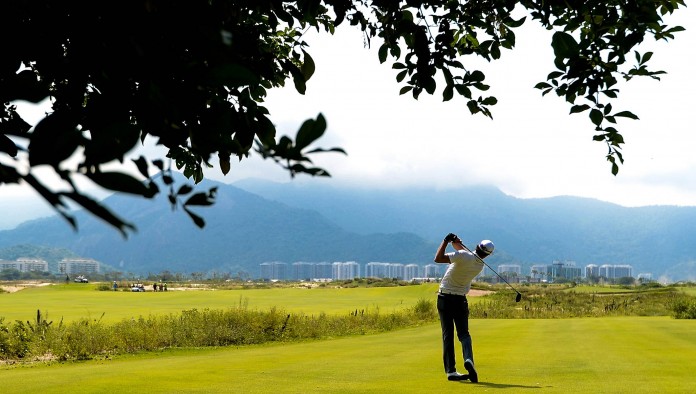 RIO 2016 MARKED A MOMENTOUS OCCASION FOR THE GOLFING WORLD, AS IT MARKED THE RETURN OF THE SPORT TO THE SENIOR OLYMPIC STAGE FOR THE FIRST TIME IN OVER A CENTURY. WITH A STATE-OF-THE-ART COURSE, DESIGNED BY ONE OF THE WORLD’S LEADING GOLF COURSE ARCHITECTS, BOTH THE MEN’S AND WOMEN’S TOURNAMENTS LIVED UP TO EXPECTATIONS, WITH MANY OF THE WORLD’S BEST PLAYERS PRODUCING SOME THRILLING GOLF.
RIO 2016 MARKED A MOMENTOUS OCCASION FOR THE GOLFING WORLD, AS IT MARKED THE RETURN OF THE SPORT TO THE SENIOR OLYMPIC STAGE FOR THE FIRST TIME IN OVER A CENTURY. WITH A STATE-OF-THE-ART COURSE, DESIGNED BY ONE OF THE WORLD’S LEADING GOLF COURSE ARCHITECTS, BOTH THE MEN’S AND WOMEN’S TOURNAMENTS LIVED UP TO EXPECTATIONS, WITH MANY OF THE WORLD’S BEST PLAYERS PRODUCING SOME THRILLING GOLF.
However, just as important was the goal of creating a lasting legacy for the sport, in a country where golf has yet to establish deep roots. Shortly after the Games, the golf course built for Rio 2016 opened its doors to the public, and as well as hosting the country’s top professional tournament, is very much at the centre of a drive to broaden participation at grassroots level.
“The great legacy is that any citizen, rich or poor, can come here and get in contact with the sport. This is the true legacy of the golf course, the access to everyone,” says Carolos Favoreto, course director.
And according to Euclides Gusi, president of Brazilian Golf Confederation, the future of golf in his country has never looked better – both at elite and grassroots levels – and the legacy created by the Olympic Games Rio 2016 has played a major part in that, thanks in large measure to the fact that the impressive facilities are a public resource to be enjoyed by locals and tourists alike.
THE GREAT LEGACY IS THAT ANY CITIZEN, RICH OR POOR, CAN COME HERE AND GET IN CONTACT WITH THE SPORT. THIS IS THE TRUE LEGACY OF THE GOLF COURSE, THE ACCESS TO EVERYONE
Carolos Favoreto
“The golf course was opened to public on 1 October 2016,” explains Gusi. “It is a public space, so there is no need to be a member or a golf pro to enjoy it – the only thing you need is to pay your entry fee. Rio City Council signed an agreement with the company that built the course and the land owners to ensure that the course will remain in public hands for at least 10 years, with an option to extend the lease for a further 10. Since the end of last year, it is now being jointly managed by the Brazilian Golf Confederation (BGC).
“Last September, just a week after the end of Rio 2016 Paralympic Games, the course hosted its first ‘post-Olympic tournament, the Brazilian Open, which is part of the PGA Latin America Tour, the continent’s top tier professional golf circuit. This year there is a strong possibility that we will stage the event on the course again. The Brazilian Open is the biggest golf tournament in Brazil, with World Ranking points at stake.
Meanwhile Favoreto, who is also an environmental scientist whose organisation has been involved in ensuring that the course meets all of the necessary environmental standards, claims that the work done to ensure the positive environmental impact of the golf course and surrounding area post-Rio 2016 is “the biggest project I’ve ever seen in terms of protection of fauna and flora environmental and ecosystem recovery,” he explains
“We won two international awards (from Golf Digest and Golf Magazine) and two national awards (Lagoa Viva and Moção da Camara dos Vereadores) for the work done to ensure the environmental legacy of the course lives on. We have a team of 20 highly skilled professionals engaged in the ongoing work in the area of flora species management, relocation of animal species, and construction of ecological protected channels, which means that we have been able to create a successful biodiversity programme that extends beyond the course itself.”
The environmental recovery work carried out on and around the golf course since the Games has seen it recognised with certification from the respected GEO Certified® Development organisation. And Favoreto says that they have recently broadened their scope to focus on programmes designed to educate and engage schoolchildren.
Now, environmental programmes are focused not just on biodiversity, but also on social initiatives. “Every month we stage the “Golfe que te quero Golfe” programme in primary schools, where children combine learning about the environment with the opportunity to try their hand at golf,” adds Favoreto.
I came here twice to watch the Games and they inspired me to play,” says 11-year-old Gabriel, one of hundreds of children whose interest in the sport has been sparked by Rio 2016 and the subsequent opportunity to try it out for themselves.
Meanwhile, golf federation president Gusi is looking ahead to the future with optimism, and sees the Riocourse as integral to plans to spread the popularity of his sport. “The Brazilian Golf Confederation will always support any initiative that can help golf grow in Brazil and will be available to share our expertise and the experience gained from Rio 2016 to help keep the legacy alive.”







